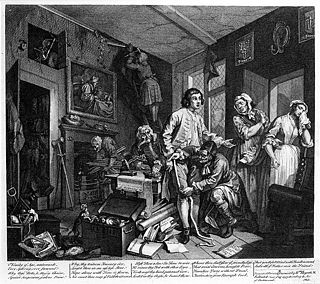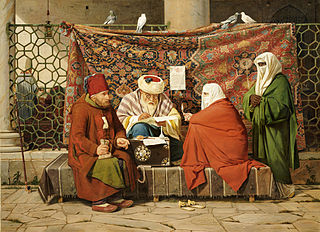
Concubinage is an interpersonal and sexual relationship between two people in which the couple does not want to, or cannot, enter into a full marriage. Concubinage and marriage are often regarded as similar, but mutually exclusive.

Inheritance is the practice of receiving private property, titles, debts, entitlements, privileges, rights, and obligations upon the death of an individual. The rules of inheritance differ among societies and have changed over time. Officially bequeathing private property and/or debts can be performed by a testator via will, as attested by a notary or by other lawful means.
Infanticide is the intentional killing of infants or offspring. Infanticide was a widespread practice throughout human history that was mainly used to dispose of unwanted children, its main purpose being the prevention of resources being spent on weak or disabled offspring. Unwanted infants were usually abandoned to die of exposure, but in some societies they were deliberately killed. Infanticide is broadly illegal, but in some places the practice is tolerated, or the prohibition is not strictly enforced.
Female infanticide is the deliberate killing of newborn female children. Female infanticide is prevalent in several nations such as China, India and Pakistan. It has been argued that the low status in which women are viewed in patriarchal societies creates a bias against females. The modern practice of gender-selective abortion is also used to regulate gender ratios.
Zināʾ (زِنَاء) or zinā is an Islamic legal term referring to unlawful sexual intercourse. According to traditional jurisprudence, zina can include adultery, fornication, prostitution, rape, sodomy, incest, and bestiality. Zina must be proved by testimony of four Muslim eyewitnesses to the actual act of penetration, confession repeated four times and not retracted later. The offenders must have acted of their own free will. Rapists could be prosecuted under different legal categories which used normal evidentiary rules. Making an accusation of zina without presenting the required eyewitnesses is called qadhf (القذف), which is itself a hudud offense.

In Islam, nikah is a contract exclusively between a man and woman. Both the groom and the bride are to consent to the marriage of their own free wills. A formal, binding contract – verbal or on paper – is considered integral to a religiously valid Islamic marriage, and outlines the rights and responsibilities of the groom and bride. Divorce in Islam can take a variety of forms, some executed by a husband personally and some executed by a religious court on behalf of a plaintiff wife who is successful in her legal divorce petition for valid cause. Islamic marital jurisprudence allows Muslim men to be married to multiple women.

Islamic feminism is a form of feminism concerned with the role of women in Islam. It aims for the full equality of all Muslims, regardless of gender, in public and private life. Islamic feminists advocate for women's rights, gender equality, and social justice grounded in an Islamic framework. Although rooted in Islam, the movement's pioneers have also utilized secular, Western, or otherwise non-Muslim feminist discourses, and have recognized the role of Islamic feminism as part of an integrated global feminist movement.
Gender roles in Islam are based on scriptures, cultural traditions, and jurisprudence.

Islamic views on slavery represent a complex and multifaceted body of Islamic thought, with various Islamic groups or thinkers espousing views on the matter which have been radically different throughout history. Slavery was a mainstay of life in pre-Islamic Arabia and surrounding lands. The Quran and the hadith address slavery extensively, assuming its existence as part of society but viewing it as an exceptional condition and restricting its scope. Early Islamic dogma forbade enslavement of dhimmis, the free members of Islamic society, including non-Muslims and set out to regulate and improve the conditions of human bondage. Islamic law regarded as legal slaves only those non-Muslims who were imprisoned or bought beyond the borders of Islamic rule, or the sons and daughters of slaves already in captivity. In later classical Islamic law, the topic of slavery is covered at great length.

The experiences of Muslim women vary widely between and within different societies. At the same time, their adherence to Islam is a shared factor that affects their lives to a varying degree and gives them a common identity that may serve to bridge the wide cultural, social, and economic differences between them.
Islamic Inheritance jurisprudence is a field of Islamic jurisprudence that deals with inheritance, a topic that is prominently dealt with in the Qur'an. It is often called Mīrāth, and its branch of Islamic law is technically known as ʿilm al-farāʾiḍ.
Many social changes took place under Islam between 610 and 661, including the period of Muhammad's mission and the rule of his four immediate successors who established the Rashidun Caliphate.
Traditional Sunni and Shia Islamic marital jurisprudence allows Muslim men to be married to multiple women. Men can have up to four wives at a time according to the islamic jurisprudence.

The topic of Islam and children includes Islamic principles of child development, the rights of children in Islam, the duties of children towards their parents, and the rights of parents over their children, both biological and foster children.

The roles of women in the Arab world have changed throughout history, as the culture and society in which they live has undergone significant transformations. Historically, as well as presently, the situation of women differs greatly between Arabic speaking regions, their urban or rural population and age groups. Among other factors, these differences can be attributed to local traditions, culture and religion, women's social or legal status, their level of education, health or self-awareness. Since the 19th century, and notably through the influence of the colonization in North Africa, the Arab Renaissance in Egypt, Lebanon, and Syria, and the end of the Ottoman Empire, the social and economic changes in the Arab world have become greatly accelerated and diversified.
Breastfeeding is highly regarded in Islam. The Qur'an regards it as a sign of love between the mother and child. In Islamic law, breastfeeding creates ties of milk kinship that has implications in family law. Muslims throughout the world have varied breastfeeding traditions.
Khitan or Khatna is the Arabic term for circumcision, and the Islamic term for the practice of religious male circumcision in Islamic culture. Male circumcision is widespread in the Muslim world, and accepted as an established practice by all Islamic schools of jurisprudence. It is considered a sign of belonging to the wider Muslim community (Ummah).
In pre-Islamic Arabia, a variety of different marriage practices existed. The most common and recognized types of marriage at this time consisted of: marriage by agreement, marriage by capture, marriage by mahr, marriage by inheritance and Mutah or temporary marriage.
Islamic family jurisprudence or Islamic family law or Muslim Family Law is the fiqh of laws and regulations related to maintaining of Muslim family, which are taken from Quran, hadith, fatwas of Muslim jurists and ijma of the Muslims. It contains pubertal, marital, sexual, child upbringing, adoption and fostering, inheritance, criminal and other related subjects. The subject mainly discusses on foster relationship, marriage, divorce, Ila, li'an, Raj'ah, Khul', Zihar, Iddah, custody and maintenance of children etc. From the political aspects, Muslim family law is a part of almost every national constitution of the world regarding religious (Muslim) laws, especially of the Muslim-majority countries.

In classical Islamic law, a concubine was a slave-woman with whom her master engaged in sexual relations. Concubinage was widely accepted by Muslim scholars in pre-modern times. Most modern Muslims, both scholars and laypersons, believe that Islam no longer permits concubinage and that sexual relations are religiously permissible only within marriage.








